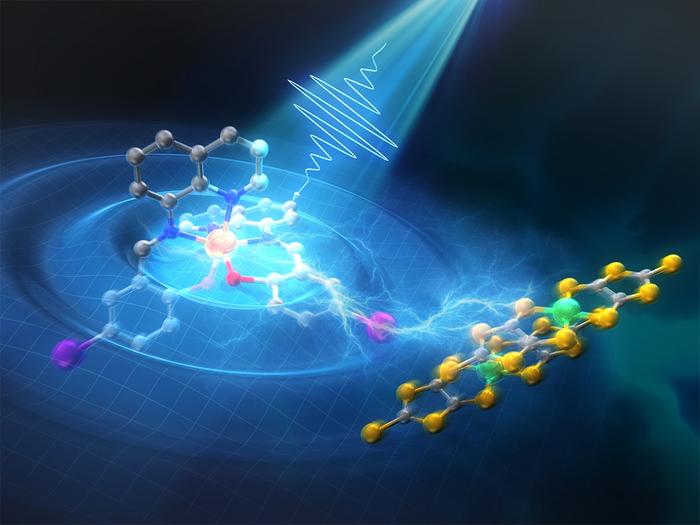Researchers uncover how the halogen bond can be exploited to direct sequential dynamics in the multi-functional crystals, offering crucial insights for developing ultrafast-response times for multilevel optical storage.

Credit: Tadahiko Ishikawa, Nature Communications
Researchers uncover how the halogen bond can be exploited to direct sequential dynamics in the multi-functional crystals, offering crucial insights for developing ultrafast-response times for multilevel optical storage.
Halogen bonds are intermolecular interactions that arise from the attraction between a halogen atom (group 17 elements in the periodic table) and another atom with lone pairs, more generally a molecular entity with high electron density. Understanding the distinctive and highly directional nature of halogen bonds is crucial for crystal engineering and studying photoinduced structural deformations, which is key for the development of innovative photo-functional materials.
However, the influence of halogen bonds on the rapid photoinduced changes within supramolecular systems remains largely unexplored due to a lack of experimental techniques that can directly observe the halogen bond in action.
To solve this problem, a team of researchers, led by Assistant Professor Tadahiko Ishikawa from the Department of Chemistry at the School of Science at Tokyo Institute of Technology (Tokyo Tech), Associate Professor Kazuyuki Takahashi affiliated with Kobe University, Dr. Yifeng Jiang affiliated with the European X-Ray Free-Electron Laser Facility (EuXFEL), and Professor R. J. Dwayne Miller affiliated with University of Toronto, explored the photoinduced dynamics associated with the halogen bonds of the prototypical halogen-bonded multifunctional system [Fe(Iqsal)2][Ni(dmit)2]·CH3CN·H2O on the ultrafast timescale, triggered by change in electron spin or spin crossover (SCO) mechanics. The study, which is a collaborative research project involving Tokyo Tech, EuXFEL, University of Potsdam, University of Toronto, University of Tsukuba, and Kobe University, has been detailed in the journal Nature Communications.
SCO is a phenomenon observed in some transition-metal coordination complexes, wherein a spin transition between low-spin (LS) and high-spin (HS) states is triggered through changes in temperature, pressure, or light. SCO accompanies relatively large volume changes and can be controlled by photoinducing different responses in the multifunctional crystals. [Fe(Iqsal)2][Ni(dmit)2]·CH3CN·H2O is a typical example of such multifunctional crystals, which exhibits both thermally- and photo-induced SCO-related phase transitions. In this system, [Fe(Iqsal)2]+ cations and [Ni(dmit)2]– anions are bound by halogen bonds.
“SCO of the [Fe(Iqsal)2]+ cations leads to a phase transition between low-temperature (LT) and high-temperature (HT) phases in our target material due to intermolecular interactions,” explains Ishikawa. “The LT phase exhibits LS state of the [Fe(Iqsal)2]+ cations and strong dimerization of the [Ni(dmit)2]– anions, while the HT phase exhibits HS state cations and weak dimerization of anions. The question is how does the halogen bond direct electron density and spin changes to impact functions as part of undergoing these phase transitions. Can we control the phase and material properties?”
The researchers investigated the ultrafast photoinduced molecular dynamics involving SCO of the [Fe(Iqsal)2]+ cations and dimerization of the [Ni(dmit)2]– anions by combining three methods: time-resolved transient visible absorption spectroscopy, time-resolved mid-infrared reflectivity spectroscopy, and ultrafast electron diffraction to study the dynamics from different viewpoints, covering electronic, vibrational, and structural aspects of the system. This comprehensive approach allowed for a thorough investigation of the photoinduced change of the states, providing a deeper understanding of the underlying processes and intermediates involved. They discovered the existence of a photoinduced transient intermediate state (TIS) different from the LT and HT phases, characterized by the HS state of [Fe(Iqsal)2]+ cations with strong dimerization of [Ni(dmit)2]– anions. This TIS state is achieved in the ultrafast timescale, within a few picoseconds, while the final state, similar to the HT phase, is achieved through sequential slow dynamics over approximately 50 picoseconds.
Furthermore, to elucidate the role of the halogen bonds in the above-mentioned photoinduced sequential dynamics, the researchers conducted quantum chemistry calculations using the ultrafast electron diffraction results. Their analysis revealed the persistence of halogen bonds between the cation and the anion guiding the sequential dynamics. Photoexcitation of the [Fe(Iqsal)2]+ cation expands the SCO ligand shell, reaching TIS. This state, being unstable, transfers the excess energy of the [Fe(Iqsal)2]+ cation to the [Ni(dmit)2]– anions through vibrational energy transfer via halogen bonds. In addition, the rapid expansion of the SCO ligand shell builds strain on the nearest [Ni(dmit)2]– anions in the halogen bond direction. These two effects result in dimer softening of the [Ni(dmit)2]– anions. The researchers developed a short video to illustrate these ultrafast dynamics.
Overall, the present results underscore the importance of halogen bonds in the photoinduced dynamics, offering a better understanding of the synergistic spin transition. “Our study highlights the importance of ultrafast investigations in monitoring ultrafast electronic and structural dynamics,” remarks Jiang. “Overall, our study highlights the potential for utilizing halogen bonds for fine-tuned functional control in photo-active supramolecular systems, with applications in fast multilevel optical data storage.”
###
About Tokyo Institute of Technology
Tokyo Tech stands at the forefront of research and higher education as the leading university for
science and technology in Japan. Tokyo Tech researchers excel in fields ranging from materials
science to biology, computer science, and physics. Founded in 1881, Tokyo Tech hosts over 10,000
undergraduate and graduate students per year, who develop into scientific leaders and some of the
most sought-after engineers in industry. Embodying the Japanese philosophy of “monotsukuri,”
meaning “technical ingenuity and innovation,” the Tokyo Tech community strives to contribute to
society through high-impact research.
https://www.titech.ac.jp/english/
Journal
Nature Communications
DOI
10.1038/s41467-024-48529-1
Method of Research
Experimental study
Subject of Research
Not applicable
Article Title
Direct observation of photoinduced sequential spin transition in a halogen-bonded hybrid system by complementary ultrafast optical and electron probes
Article Publication Date
4-Jun-2024




